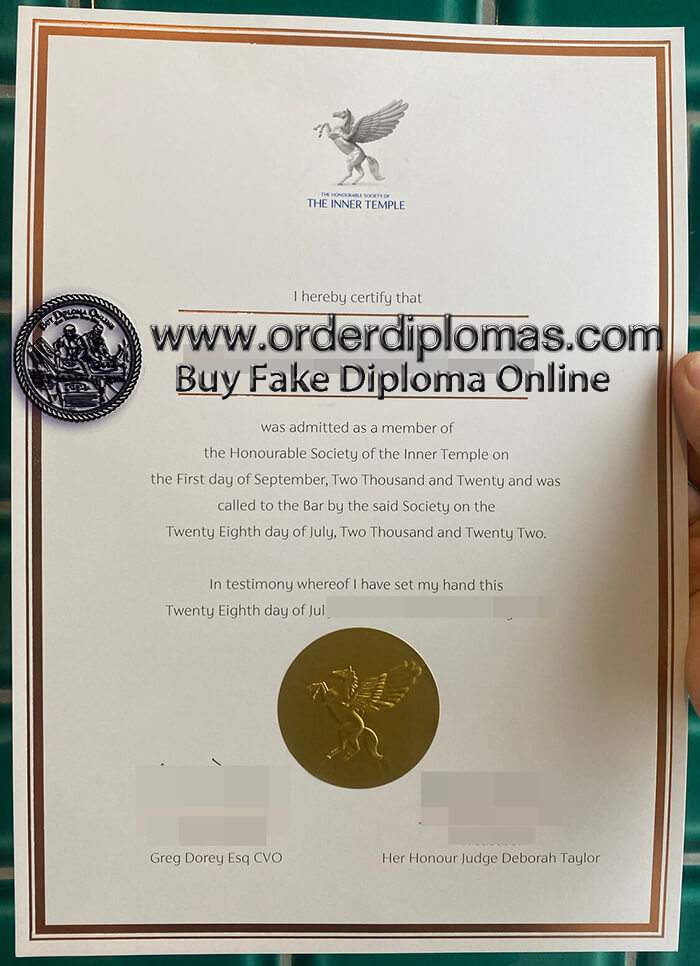
buy fake INNER TEMPLE certificate
How to buy fake Inner Temple diploma? how to buy fake Inner Temple degree? how to buy fake Inner Temple degree certificate? buy fake diploma, buy fake INNER TEMPLE degree. buy fake INNER TEMPLE certificate.
The Honourable Society of the Inner Temple, commonly known as the Inner Temple, is one of the four Inns of Court and is a professional associations for barristers and judges. To be called to the Bar and practise as a barrister in England and Wales, a person must belong to one of these Inns. It is located in the wider Temple area, near the Royal Courts of Justice, and within the City of London.
The Inn is a professional body that provides legal training, selection, and regulation for members. It is ruled by a governing council called “Parliament”, made up of the Masters of the Bench (or “Benchers”), and led by the Treasurer, who is elected to serve a one-year term. The Temple takes its name from the Knights Templar, who originally (until their abolition in 1312) leased the land to the Temple’s inhabitants (Templars). The Inner Temple was a distinct society from at least 1388, although as with all the Inns of Court its precise date of founding is not known. After a disrupted early period (during which the Temple was almost entirely destroyed in the Peasants’ Revolt) it flourished, becoming the second-largest Inn during the Elizabethan period (after Gray’s Inn).
The Inner Temple expanded during the reigns of James I and Charles I, with 1,700 students admitted between 1600 and 1640. The First English Civil War’s outbreak led to a complete suspension of legal education, with the Inns close to being shut down for almost four years. Following the English Restoration the Inner Templars welcomed Charles II back to London personally with a lavish banquet.
After a period of slow decline in the 18th century, the following 100 years saw a restoration of the Temple’s fortunes, with buildings constructed or restored, such as the Hall and the Library. Much of this work was destroyed during The Blitz, when the Hall, Temple, Temple Church, and many sets of barristers’ chambers were devastated. Rebuilding was completed in 1959, and today the Temple is a flourishing and active Inn of Court, with over 8,000 members.
The 18th century was a period of relative stability, with an element of decline. The Benchers of the time were described as “opposed to all modern fashions, including new-fangled comforts”, with the Inn’s buildings deteriorating. Much of the Temple was rebuilt during the 19th century, most noticeably the Hall and Library, although fever and disease continued as a result of the Inn’s outdated systems; the same water was used both for drinking and for flushing the toilet, for example.
In 1922 the Temple called Ivy Williams to the bar, making her the first female barrister in England and Wales. The Temple suffered massively during The Blitz in the Second World War, including attacks on 19 September and 26 September 1940, which destroyed the Library clocktower and the Hall respectively; on 10–11 May 1941 the Inn was hit by a series of incendiaries which destroyed the inside of Temple Church, the Hall, the Library and many sets of chambers. Fires continued to burn for another day, despite the assistance of the Fire Brigade and several barristers and employees.
It was decided not to start rebuilding until after the cessation of hostilities, and plans began in 1944, when the Temple contacted the War Damage Commission to provide the £1.5 million to cover the damage. £1.4 million was provided, with the rest found elsewhere. There was a further delay due to the Temple’s choice of architect, Hubert Worthington, who was so slow that the Benchers ended up replacing him with his junior associate, T.W. Sutcliffe, and eventually Sir Edward Maufe. The chambers were the priority, with parts of King’s Bench Walk finished in 1949, and the final building (the Library) was opened on 21 April 1958.
In 2001 the Inner Temple bought the neighbouring 1–2 Serjeant’s Inn, which can be accessed directly from the Inner Temple, with the intention of converting it to barristers’ chambers. However, instead, the premises has been let on a 99-year lease to Apex Hotels. No. 3 Serjeant’s Inn has been a barristers’ chambers, occupying commercial premises, since 1986. Mitre Court, which connects the Inner Temple area, Serjeant’s Inn and Fleet Street, is occupied as barristers’ chambers, residential flats and more recently, solicitors.

 USA Diplomas
USA Diplomas Canada Diplomas
Canada Diplomas UK Diplomas
UK Diplomas Australia Diplomas
Australia Diplomas Germany Diplomas
Germany Diplomas Malaysia Diplomas
Malaysia Diplomas Singapore Diplomas
Singapore Diplomas Other countries
Other countries Transcript-Form.xlsx
Transcript-Form.xlsx
